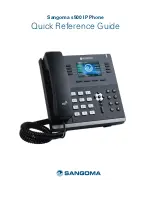
78
The Call Coverage conditions that you can assign specific greetings to are select-
ed by the following digits:
1
Primary/No Answer Greeting
Used when in your office, away from your desk or during the time period you
are scheduled available. If this is the only Personal Greeting you record, it will
play for all call coverage conditions.
This option is available only if the Administrator has assigned you the 'Basic
Greeting' feature.
Example:“Hi this is John Smith. I'm sorry I am not available to answer your call.
If someone else can help you, please enter the extension number now. Or, to
leave me a message, press 1.”
2
Busy Greeting
Played to a caller when you are already talking to someone on your extension
or the telephone at your Designated Location.
This option is available only if the Administrator has assigned you the 'Busy
Greeting' feature.
Example:“Hi, this is John Smith. I'm on another line right now. If someone else
can help you, please enter the extension number now. Or, to leave a message,
press 1.”
3
Call Blocking Greeting
Used while Call Blocking is enabled in your Access Manager or if your phone
is forwarded ALL or DND.
This option is available only if the Administrator has assigned you the 'Call
Blocking' feature.
Example:“Hi, this is John Smith. Sorry I missed your call, but I'm going to be out
of the office for the next few hours. If someone else can help you, please enter
the extension number now. Or, to leave me a message, press 1.”
4
Night Greeting
Used during the time period you are scheduled UNAVAILABLE, usually after
business hours during the evening and at night.
This option is available only if the Administrator has assigned you the
'Scheduling' feature.
Example:“Hi, this is John Smith. I've left the office for the evening. If you would
like to try someone else, please enter the extension number now. Or, to leave
me a message, press 1.”
smt-i3105_combined_user_guide.qxp 4/26/2010 2:13 PM Page 78
79
5
Call Screening Greeting
Used while Call Screening is enabled, and you REJECT a caller after listening to
the caller's record name.
This option is available only if the Administrator has assigned you the 'Call
Screening' feature.
Example:“Hi, this is John Smith. I'm sorry, but I am not available to speak with
you at this time. If someone else can help you, please enter the extension
number now. Or, to leave me a message, press 1.”
6
Edit Personal Greetings
You may also edit/record each one of the greetings (1-9) at any time.
Select a greeting number to edit and follow the instructions to record your
greeting. When you are done recording your greeting, you will be able to lis-
ten to the greeting you recorded, save the greeting you recorded and return
to the previous menu, record the greeting again, or exit without saving the
greeting.
Note: If you record only the greeting assigned to the No-Answer Call Coverage
Condition, then that greeting will play to callers for all Call Coverage
Conditions (No-Answer, Busy, Blocked, Night, and Rejected Caller). In this case,
the salutation part of the greeting should be very general.
7
Edit Mailbox Greeting
Used whenever a caller reaches your mailbox or if you have not recorded any
of the Call Coverage greetings. The way a caller is transferred to your mailbox
greeting directly, is by another subscriber transferring the caller to your mail-
box using the VT (VoiceMail Transfer) key.
This option is available only if the Administrator has assigned you the 'Mailbox
Greeting Option' feature.
Example: “Hi, this is John Smith. Please leave me a message, I will call you as
soon as I can.”
Note: This greeting will only play if none of the 5 personal greetings has
played to the caller. A common usage for this Greeting is when another
Subscriber is talking with a caller and uses the VT key on their phone to trans-
fer the caller directly to your Mailbox.
smt-i3105_combined_user_guide.qxp 4/26/2010 2:13 PM Page 79







































